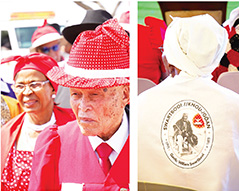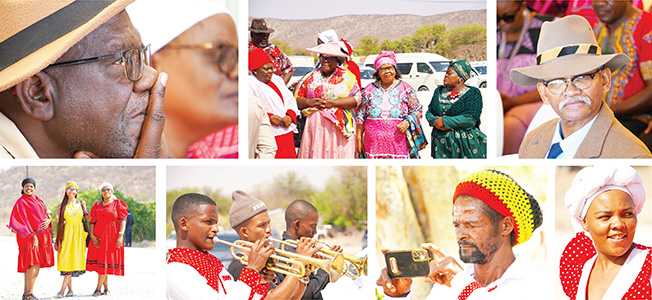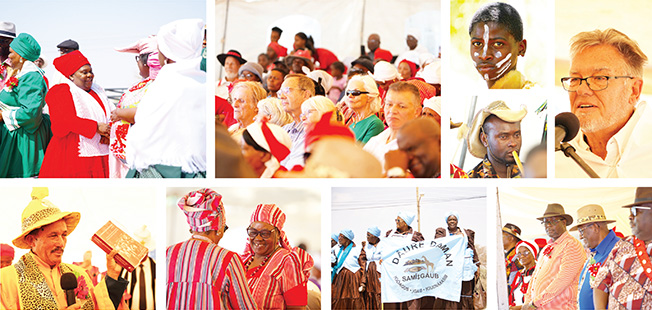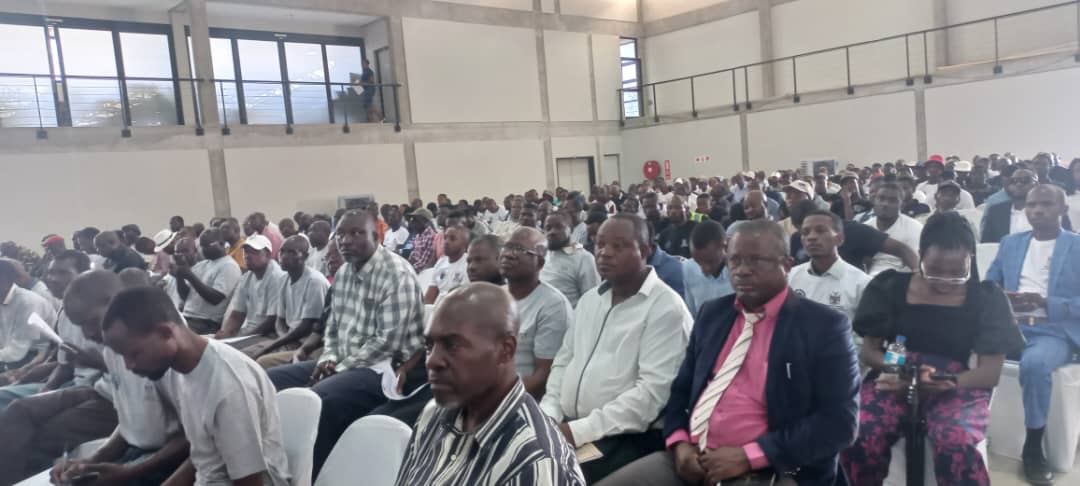The sun rose gently over Fransfontein, casting warm hues over the hills, where the small but historic settlement has stood for generations.
Fransfontein, a place whose name traces back to the fountain discovered by its namesake, Frans Fredrick, became the heart of celebration as the Swartbooi Traditional Authority gathered to witness the coronation of Charles Otto Williams /Uirab, (chief) gaob-designate.
With a rich historical backdrop, /Uirab’s ascension to leadership carries the weight of centuries-old traditions and memories of past migrations.
The air was thick with anticipation as community members – dressed in bright reds, yellows and blues – made their way to the site where the coronation would take place.
During the event, several of the women wore red dresses with white polka dots, which made for a striking picture. This traditional outfit, significant for Swartbooi clan ancestors, represented their relationship with the newly crowned leader.

The Swartbooi clan, a subgroup of the Nama Oorlams, trace their roots back to the early 1700s, when their first gaob, Kanabeb, led the formation of the Swartbooi clan. Born with a darker complexion compared to others in the clan, Kanabeb became known as ‘Swartbooi’, a Dutch term meaning ‘black boy’, and this name has carried through the lineage to the present day.
With five brothers, Kanabeb’s family had a number of internal disagreements, resulting in the Swartboois relocating multiple times over the years.
Initially moving from the Northern Cape, the Swartbooi clan would eventually find themselves at Rehoboth in the 1860s. Their movements were not without reason — each migration brought them closer to finding lands with better access to water and agriculture.
One of their most significant moves led them toward the banks of the Kunene River at a site now known as Swartbooisdrift, and some moved further north into southern Angola.
Still, this was not their final destination, as they moved south again to Otjitambi, but the salty water in the area prompted chief Cornelius Swartbooi to send Frans Fredrick on an exploratory mission to find more suitable lands for the clan.

Fredrick’s exploration bore fruit when he discovered a fountain, now the central water source of what is known today as Fransfontein.
Cornelius Swartbooi, a key leader in the 19th century, further developed the area with the help of a British geologist, ensuring its role as a lifeline for the community’s agricultural activities. The area’s discovery made it ideal for settlement, and over time, other communities near Fransfontein, joined the Swartbooi clan.
Daniel Luiperdt, who was gaob from 2000 in terms of the Traditional Authorities Act until 2020 – when Charles /Uirab was designated acting chief – formally passed the baton to his son, ensuring that the Swartbooi authority’s leadership was anchored in both tradition and familial continuity.
When the time came for /Uirab to take his place as chief, the crowd hushed. As the chief robe was handed to /Uirab to wear, women broke into ululation, the sound reverberating across the crowd, signalling the beginning of a new dawn for the Swartbooi clan.
Amid the jubilant celebrations, chief /Uirab addressed the crowd, his voice carrying a message of unity and progress.
“Today marks a new beginning for our people,” he declared. “But it is also a continuation of the journey started by our forefathers.
We are here because of their sacrifices, and as we look to the future, we must carry forward the values they instilled in us.”
/Uirab also acknowledged the presence of neighbouring communities and traditional authorities.

Traditional leaders, including king of the Aandonga people, tate Omukwaniilwa Fillemon Shuumbwa Nangolo, along with other dignitaries, emphasised the significance of collaboration and mutual respect across different cultural groups in conserving their legacies and building a common path ahead for Namibia’s indigenous leadership structures.
Horst Kleinschmidt, a descendant of the German missionary lineage dating back to the early 1800s, added to the day’s historical significance by sharing his personal link to the Swartbooi clan. Kleinschmidt shared fascinating details about his family’s history, beginning with his ancestor, missionary Hinrich Schmelen, who was in Cape Town in 1811.
Schmelen later married a Khoikhoi woman, tying Kleinschmidt’s genealogy to the Swartbooi and Khoisan. Kleinschmidt, who had undertaken ancestral DNA testing, revealed that 4% of his heritage can be traced back to the Khoisan, highlighting the strong, historical relationships that span generations.
Just a few kilometres from Fransfontein, Damara Mopane Lodge, part of Gondwana Collection Namibia, offered a modern reflection of the region’s timeless sense of community.
The lodge, known for its ethos of “hello neighbour,” aligns perfectly with the warm hospitality of the Swartbooi people and the celebrations that were ongoing.
Guests who travelled to witness the coronation were welcomed with open arms, just as the lodge has long welcomed travellers to explore the cultural richness of the area.

Stay informed with The Namibian – your source for credible journalism. Get in-depth reporting and opinions for
only N$85 a month. Invest in journalism, invest in democracy –
Subscribe Now!






